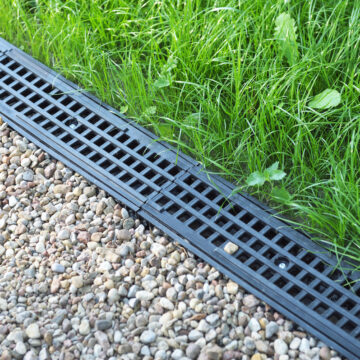Poor drainage is enough to turn any enviously green lawn into a mushy mess, but there are three primary types of landscape drainage systems that can help save your next backyard barbecue! Each of these landscape systems specializes in mediating different types of drainage issues. But how can you tell when your yard is struggling with drainage and which system is best suited for your lawn?
Signs of Poor Landscape Drainage
- soil erosion
- loose topsoil
- water-stained foundation
- standing water underneath gutter spouts
- flooding walkways or driveway
All of these are telltale signs that your lawn is in desperate need of better drainage. Cracked pipes, yard slope, lack of downspouts and other factors can prevent your lawn from draining properly, especially during heavy rain. If you should be experiencing any of these signs, skipping the hassle of muddy shoes and frequent dog baths with a new drainage system is well worth it!
Types of Landscape Drainage Systems
To fix the most common drainage problems, professional landscaping companies will most likely propose one of the basic three types of landscape drainage issues including dry wells, French drains and gutter drains.
Dry Well
A dry well is a cylindrical underground reservoir designed to accumulate water runoff and slowly reintroduce it back into the soil. This landscape drainage method is made possible by the dry well’s porous siding. Instead of accumulating above ground, this drainage system slowly introduces the water a few feet below the surface. A dry well is most used for water that is more difficult to redirect such as driveway grates or downspouts. Whether or not this is the best drainage option for your lawn depends on a variety of factors such as rainfall, soil composition and the height of the water table.
French Drain
A French drain is a type of landscape drainage system specifically designed to eliminate pools of water caused by low-lying areas. French drains operate somewhat like gutters, but instead of taking care of water above, French drains redirect water accumulating on the ground. These functional drains are composed of perforated piping layered with filter fabric and topped with gravel. Thanks to their often-stylish nature, French drains are frequently used in conjunction with front yard landscaping to divert water accumulating in plant beds or pots.
Gutter Drains (Downspout/Sump Pump Drainage)
Another drainage system option would be the connection of gutter downspouts and/or basement sump pump lines via drain pipe and redirecting them to an area with better drainage. The termination point at the end of the drainpipe has several different options. A catch basin with a grate can be used to allow a free flow of water to escape and is very easy to cleanout.
A pop-up emitter is another type of drain termination point. A pop-up emitter is very low profile and is normally hidden amongst the surrounding landscape. It has a top that opens to release water with the help of hydrostatic pressure and closes as the pressure decreases.
Downspout drains and/or sump pumps can also be extended directly into a dry well. In some cases, a dry well may be the only option for properties with a little to negative grade, or a municipality with specific codes not allowing the re-direction of stormwater runoff towards the street.
Which type of landscape drainage is best for you?
While there are many different types of landscape drainage systems available, these three primary systems are some of the most common and effective solutions. Dry wells, French drains and downspout/sump connections all help to prevent stagnant or pooling water with their respective strong suits. If left untreated, poor landscape drainage can lead to soil erosion, loose topsoil, mildew, basement flooding and water staining. Installing a landscape drainage solution alongside any type of irrigation system can help prevent water collection in walkways, driveways, low-lying areas and more, preserving your lawn and saving you money in the process! For more information about the different types of landscape drainage systems and which is right for you, contact us today!

